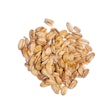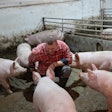
Piglets given ad libitum access to milk replacers gained more weight and grew faster compared with other feeding strategies, reports new research published in the Journal of Animal Science.
Providing milk replacer to piglets in situations where natural nursing is limited or unavailable is becoming more common in the U.S. pork production system. This study, conducted by researchers at the University of Illinois Urbana-Champaign, aimed to better understand how early nutrition impacts pig growth, metabolism, behavior and welfare.
For the study, 85 weaned piglets were fed milk replacer freely or received carefully measured doses of milk replacer. The second feeding strategy was designed to mimic the frequency and quantity of milk a piglet would get from a sow.
Researchers tracked body weight, insulin concentration, behavior and soft tissue composition over the 15-day study.
Insulin production speeds weight gain
While the results revealed no significant differences in soft tissue composition, body fat and muscle protein content in the two groups of piglets, the “ad libitum pigs drank more milk overall and gained more weight,” said lead study author Kaitlyn Sommer, a doctoral researcher in the Department of Animal Sciences, part of the College of Agricultural, Consumer and Environmental Sciences at Illinois.
“When we compare how much milk they consumed relative to their body weight, both the ad libitum and prescribed feeding groups consumed similar amounts,” she added. “This suggests that ad libitum pigs are simply growing faster, possibly due to differences in insulin production.”
The quicker growth is likely due to the larger, less frequent meals consumed by the piglets given unlimited access to the milk replacer compared to the control group. The larger meals led to prolonged periods of insulin levels high enough to trigger muscle growth in the piglets, the researchers hypothesized.
The study’s findings could also be useful to biomedical research studies on human nutrition and health, where milk replacer is commonly used.

















